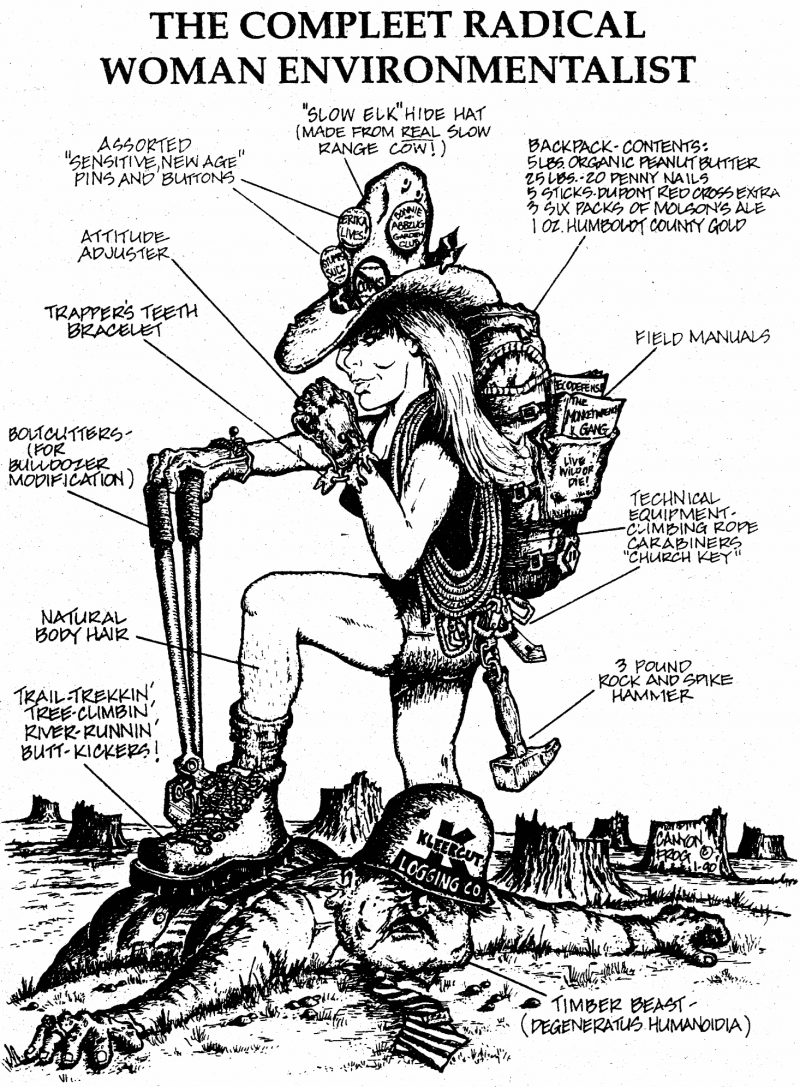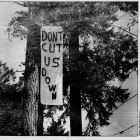The Earth First! Journal as a Gateway to Movement History
From its inception, the Earth First! movement prized robust debate. Although periodic controversies erupted about articles and views that were excluded from the pages of Earth First!—there has been an ongoing debate about whether the journal should be for outreach and therefore somewhat more moderate and without undue expression of internal disputes, or for internal, movement discussion, debate, and strategizing—reading it provides a good sense of the movement’s political and spiritual dimensions, campaigns, successes and failures, diversity, disputes, and schisms, and a window into the ways their adversaries and law enforcement authorities responded. It may be helpful to have some sense of what to look for when wading into this documentary record.
The First Decade (1980-1990)
Earth First!’s first few years (1980–1983) were characterized by largely symbolic acts, outreach, and fledgling efforts to invent a fitting cultural infrastructure and identity, which was a contentious process that would become ongoing, and was the result of differing political, religious, and strategic visions, including what sorts of tactics would be discussed in the journal and deployed in the field.
Early on, at Foreman’s direction and insistence, Earth First! published according to a pagan calendar and its masthead announced that the movement did not accept the authority of the nation-state. At the same time, he and the movement’s founders dressed in Western cowboy garb and cultivated an image as “rednecks for wilderness.” This image went well with the macho notion that they were willing to wage a guerrilla campaign that would sabotage Earth’s destroyers, but it also early on engendered criticism for promoting an alienating, patriarchal, and violent ethos. Such criticisms would lead to intense debates in the coming years.
The original exhibition includes and interactive gallery of images of the Earth First! movement. View the items on the following pages.

Dave Foreman in a Cowboy Hat
Dave Foreman cultivating the image of Earth First!ers as “rednecks for wilderness.”
Dave Foreman unleashes his tongue during this summer’s 4th of July “Sagebrush Patriots’ Rally” as he exposes the REAL traitors to the land: The “Sagebrush Rebels,” and the corporate/industrial complex behind them.

Harvey Wolke Wrestling
Howie Wolke arm wrestling at an Earth First! “Macho Night” in Jackson, Wy.
Earth First! Macho Night in Jackson, Wy. Howie Wolke grins as he prepares to beat other EF!ers at arm wrestling. Howie surprised James G. Watt at the EF! demonstration outside the Western Governor’s Conference when he reached over a Secret Service agent, took Watts’ hand and said, “Mr. Secretary, I’m Howie Wolke and I organized the Anti-Watt rally over there.”

Cowboy Johnny Sagebrush
Earth First!er Bart Koehler called his musical cowboy avatar “Johnny Sagebrush.” He produced “The Earth First! Li’l Green Songbook” in 1981, officially published as “The Earth First! Li’l Green Songbook” in 1986.
Except for a few copies we will be sending out to members who have paid for them, the Li’l Green Songbook is sold out. Johnny has been writing a lot of all-new original eco-radical tunes lately, and we are looking forward to publishing them in an expanded version of his songbook. They will probably go for about 4$ each. Note: There’s even a rumor that Johnny is planning on recording a best-selling LP one of these days!

Earth First! Mudmen
Two Earth First! “Mudmen” advertise a call for event and photo contributions for the “First Earth First! Earth Calendar,” which followed the pagan calendar.
Tired of calendars starting with January and ending with December? Year after monotonous year? Then rise up and throw off those shackles of bound conformity with the First Earth First! Earth Calendar. which begins this autumn with All Hallow’s Eve. From there we follow the grand old cycles of the Earth’s rhythm, as folks did in the days of yore. (Before all this insanity got going.) Help make this a truly seasoned effort. Send in your favorite dates, quotes, eco-catastrophes, Earth info, and any other terribly important data which you have been saving up for a time like this.




To view the caption and the source information, please click on the i in the upper left part of the image. Click on the images for a larger format.
By 1982 Foreman and many others had been introduced to and enthusiastically embraced deep ecology, a biocentric philosophy first articulated a decade earlier by the Norwegian philosopher Arne Naess. Linking this philosophy to nature religions, Foreman wrote, “Deep Ecology is the most important philosophical current of our time,” and pledged to make Earth First! a forum for such philosophy as well as for “Earth religion in whatever guise.” He even contended that “all of us are religious, even atheists like [co-founder] Howie Wolke who deifies grizzly bears and hopes to become one” (in Earth First! 2, no. 8, p. 2). Wolke considered such religious talk counterproductive and Foreman would eventually distance himself from earthen spiritualities, but given the presented image, it was not surprising that a very wide array of activists—rednecks and pagans, feminists and chauvinists, hippies and anarchists, social justice activists and misanthropes, ecologists and postmodern critics of science—would be drawn to the movement. This diversity and the contention it aroused was early and often expressed in Earth First!

According to Wikipedia, “On March 21, 1981 the radical environmental group Earth First! staged an anti-dam protest by unfurling a 300-foot (91 m) tapered black sheet of plastic down the face of the dam, making it appear as if a gigantic crack had appeared in the structure – a direct re-enactment of a scene from Abbey’s book. Authorities were unable to find the individuals responsible.” Symbolic acts such as these marked the first few years of the movement.
According to Wikipedia, “On March 21, 1981 the radical environmental group Earth First! staged an anti-dam protest by unfurling a 300-foot (91 m) tapered black sheet of plastic down the face of the dam, making it appear as if a gigantic crack had appeared in the structure – a direct re-enactment of a scene from Abbey’s book. Authorities were unable to find the individuals responsible.” Symbolic acts such as these marked the first few years of the movement.
Photograph by Everett S. Ruess.
The copyright holder reserves, or holds for their own use, all the rights provided by copyright law, such as distribution, performance, and creation of derivative works.
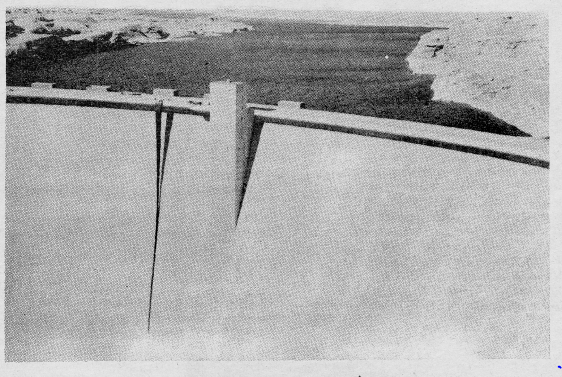
Here, the plastic “crack” is suspended over Glen Canyon Dam. This was one of the earliest actions by Earth First!, and received a lot of attention despite its symbolic nature. See Earth First! 2, no. 4.
Here, the plastic “crack” is suspended over Glen Canyon Dam. This was one of the earliest actions by Earth First!, and received a lot of attention despite its symbolic nature. See Earth First! 2, no. 4.
The copyright holder reserves, or holds for their own use, all the rights provided by copyright law, such as distribution, performance, and creation of derivative works.

“Doug Fir,” a prodigious tree-climber, hangs a banner from an old growth tree in the Middle Santiam. See Earth First! 5, no. 6.
“Doug Fir,” a prodigious tree-climber, hangs a banner from an old growth tree in the Middle Santiam. See Earth First! 5, no. 6.
Photograph by Jacqueline Moreau.
The copyright holder reserves, or holds for their own use, all the rights provided by copyright law, such as distribution, performance, and creation of derivative works.
But these were also early years of tremendous energy and innovation. By 1983, the movement’s activists were engaged in high-stakes and high-profile campaigns, attempting to halt logging and other practices they considered a threat to the natural heritage of North America and beyond. Over time, the movement also spawned many additional organizations with their own foci, such as the Rainforest Action Network and a group that would eventually become the Center for Biological Diversity, one of the most tenacious defenders of wildlands in North America.
Between 1983 and 1987, the movement experienced a dramatic expansion in numbers and campaigns, and its public profile increased. Activists started invading the offices of politicians and companies, blockading bulldozers or occupying ancient trees, and in some cases, driving metal stakes into trees or sabotaging equipment in their efforts to thwart logging. These tactics also created controversy and garnered major media attention, which activists hoped would spur increased public resistance to deforestation. Internal dissension also grew during these years, however, as anarchists (of different sorts) debated with non-anarchists, and some of the movement’s feminists, most prominently Judi Bari, objected to what they considered to be the sexism of the movement’s most prominent male leaders. Still others complained about the hierarchal structure of the journal itself and demanded a wider array of voices be included, including those advancing animal-liberationist and social-justice causes.
These are cartoon depictions of “ideal” male and female radical environmentalists. The female portrayal, in particular, received criticism from women in Earth First!, who thought it demonstrated an underlying sexism prevalent in the movement. It was debated for decades to come, particularly in the writings of Judi Bari. See Earth First! Journal 11, no. 5.
In 1987, Edward Abbey himself, who had become friends with Foreman and attended movement gatherings, was harshly criticized for supposedly sexist and racist views but was sharply defended by others, which led to deeper divisions in the movement. Leftists and anarchists promoted greater attention to economic injustices and revolutionary movements while others objected, arguing that Earth First! should stay tightly focused on the conservation of biological diversity and not get distracted by such causes, however justifiable they might be on anthropocentric or humanitarian grounds.
By the mid-1980s, Foreman had become disillusioned with the movement he had co-founded, and after the attacks on Abbey in late 1987 he decided to step back from editing the journal. The growing contention and Foreman’s decision were signs that momentum was building toward a major schism in the movement.
The original exhibition includes and interactive gallery of articles concerning the Earth First! movement. View the items on the following pages.

Dave Foreman Steps Back as Editor for Earth First! Journal (21 June 1988)
Before I turn this over to John, let me simply say that editing and publishing The Earth First! Journal has been the high point of my seventeen-year career as a preservationist. I’ve enjoyed it, and I’ve felt fulfilled in doing it. But it is time to move on.
— Dave Foreman

Dave Foreman’s and Nancy Morton’s Goodbye Letter (22 September 1990)
Both of us have smoked a lot of cigars and downed a lot of beers trying to figure out what to do. But we cannot escape the fact that we are uneasy with much in the current EF! movement. We therefore have come to the irrevocable decision to leave.
— Dave Foreman and Nancy Morton

Judi Bari’s Response (22 September 1990)
First of all, I’m not out to trash Dave Foreman. I have a lot of respect for him, both for introducing me and many others to the idea of biocentrism, and for the decentralized, non-hierarchical non-organization he helped set up in EF! But this divorce has been a long time coming, and it’s based on real political differences.
— Judi Bari


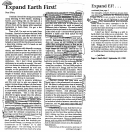
Goodbye letters and Judi Bari’s response. Click on the images for a larger format.
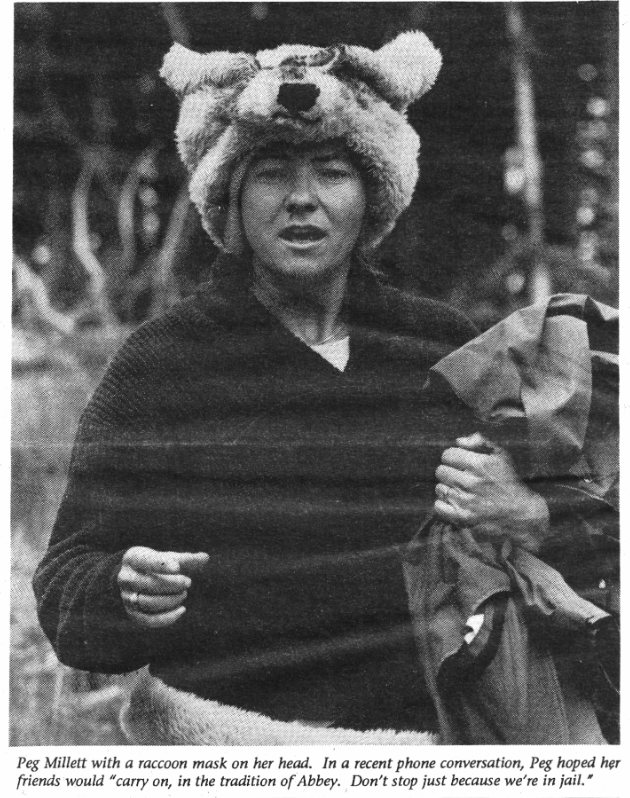
Four Earth First! members, including Dave Foreman, were arrested in May 1989 after an FBI informant infiltrated the group. The consequent arrest of a fifth activist led to the group being dubbed the “Arizona 5.” See Earth First! 9, no. 6.
Four Earth First! members, including Dave Foreman, were arrested in May 1989 after an FBI informant infiltrated the group. The consequent arrest of a fifth activist led to the group being dubbed the “Arizona 5.” See Earth First! 9, no. 6.
© Earth First!
The copyright holder reserves, or holds for their own use, all the rights provided by copyright law, such as distribution, performance, and creation of derivative works.
Between 1987 and 1990, Earth First! campaigns proliferated and intensified, law enforcement authorities infiltrated the movement and a bombing captured headlines, exacerbating internal divisions yet further. On 29 and 30 May 1989, four activists, including Foreman, were arrested by federal agents (a fifth activist was arrested later, and the group was dubbed the Arizona 5); they were accused of conspiring to topple power lines associated with a nuclear power plant, along with other crimes. All of the activists were eventually convicted; one received a six-year sentence, the second three years. Foreman himself eventually pled guilty to a misdemeanor and avoided jail altogether.
Long before the cases of the Arizona 5 were adjudicated, on 24 May 1990, a bomb exploded in a car being driven by Judi Bari in Oakland, California, nearly killing her and injuring her passenger, fellow activist Darryl Cherney. They were the most prominent leaders of an Earth First! campaign to prevent the logging of ancient redwoods in northern California. At that time they were organizing a dramatic civil disobedience campaign that, combined with tree sits and blockades, had already disrupted logging and promised to do so all the more. Although Bari had been assaulted previously and she and Cherney regularly received death threats, the authorities charged them with knowingly carrying a bomb and publicly called them ecoterrorists. The pair was eventually vindicated but Bari died from breast cancer in 1997. Five years later, in 2002, Cherney and representatives of Bari’s estate won 4.4 million US dollars in a lawsuit against officials from the FBI and Oakland Police Department, whom a jury ruled had violated Bari and Cherney’s free speech and other civil rights.

The remains of the car in which Judi Bari and Darryl Cherney were traveling after a pipe bomb tore it to pieces on 24 May 1990, leaving Bari disabled for life. See Earth First! Journal 14, no. 5.
The remains of the car in which Judi Bari and Darryl Cherney were traveling after a pipe bomb tore it to pieces on 24 May 1990, leaving Bari disabled for life. See Earth First! Journal 14, no. 5.
© Oakland Police Department
The copyright holder reserves, or holds for their own use, all the rights provided by copyright law, such as distribution, performance, and creation of derivative works.



